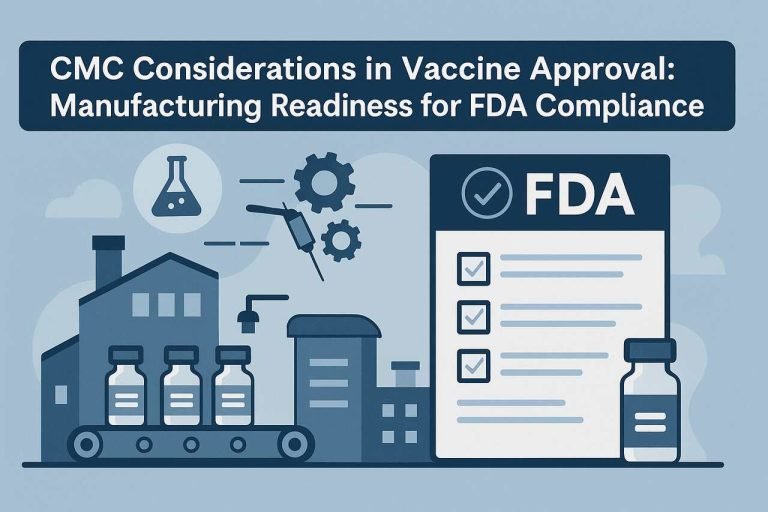In late 2020, a mid-sized biotech firm celebrated what seemed like a breakthrough: their novel influenza vaccine had just completed Phase 3 trials with strong efficacy data. Investors were enthusiastic, and public health agencies showed interest. But the celebration was short-lived. When the company submitted its Biologics License Application (BLA) to the FDA, it was met with a Complete Response Letter (CRL). The reason? Gaps in Chemistry, Manufacturing, and Controls (CMC) data. The FDA cited incomplete validation reports, inconsistencies in batch records, and missing environmental monitoring logs. Approval was delayed by over a year, triggering financial losses and reputational damage.
This real-world example underscores a critical reality: no matter how effective a vaccine is in clinical trials, it won’t reach the public without rigorous CMC compliance. For developers, understanding and planning for FDA’s CMC expectations is non-negotiable.
What is CMC and Why Does It Matter?
CMC refers to the body of data required to demonstrate that a vaccine can be manufactured consistently, safely, and in compliance with Good Manufacturing Practices (GMP). It includes details on:
- Raw materials and sourcing
- Manufacturing process and controls
- Product formulation and stability
- Facility design and operational readiness
- Analytical methods and batch release criteria
These components allow the FDA to assess whether a vaccine candidate can be reliably produced at scale, without introducing safety or quality risks.
According to FDA data, roughly 30% of vaccine-related BLAs are delayed or denied due to CMC-related issues.
Common CMC Pitfalls That Derail Approvals
1. Inadequate Process Validation
FDA expects sponsors to provide data confirming that the production process is reproducible and controlled. Failure to validate key process parameters—such as temperature holds, mixing speeds, or filtration steps—can raise red flags.
A 2023 report by the Parenteral Drug Association (PDA) found that over 40% of CRLs issued to biologics manufacturers involved deficiencies in process validation documentation.
2. Weak Stability Data
Stability studies establish a vaccine’s shelf life and acceptable storage conditions. Submitting limited time points or data generated under unrealistic conditions can result in conservative expiration dating or approval delays.
Early integration of real-time and accelerated stability studies is crucial, especially for vaccines that rely on cold chain distribution.
3. Manufacturing Facility Deficiencies
FDA conducts pre-approval inspections (PAIs) of manufacturing sites. Issues such as:
- Poor environmental monitoring
- Inadequate training documentation
- Lack of data integrity protocols
can result in a Form 483 or a Warning Letter. Facilities that are not ready to support commercial manufacturing pose a major risk to regulatory approval.
4. Inconsistent Raw Material Sourcing
Raw materials, especially biological ones like cell lines or enzymes, must be qualified and consistent. FDA expects detailed sourcing information, quality control testing, and risk mitigation strategies.
Unvetted vendors or single-source dependencies often prompt additional FDA queries.
Building a Successful CMC Strategy
The most successful vaccine sponsors treat CMC planning as an integrated pillar of development, not a back-end task. Key strategies include:
- Conducting mock FDA inspections
- Engaging in early and frequent dialogue with CBER reviewers
- Using Quality by Design (QbD) principles to map critical quality attributes
- Leveraging digital batch records and automated process controls to improve traceability and reproducibility
Cross-functional coordination between R&D, QA, regulatory affairs, and manufacturing must be embedded from early development through scale-up.
Understanding the overview of FDA vaccine review involves not only efficacy endpoints but also an appreciation of manufacturing reliability, facility quality, and compliance culture.
Lessons from Operation Warp Speed
The COVID-19 pandemic forced unprecedented acceleration of vaccine timelines. Under Operation Warp Speed, manufacturers like Moderna and Pfizer-BioNTech had to compress years of CMC development into months.
While these vaccines were initially distributed under Emergency Use Authorizations (EUAs), full BLA approvals later required comprehensive CMC data packages. FDA’s willingness to use rolling reviews and prioritize communication helped—but no corners were cut on quality or compliance.
In fact, Moderna’s full approval included over 1 million pages of documentation, including complete validation reports, extensive stability data, and inspection-ready facility records.
As the World Health Organization (WHO) emphasized in its global guidance, transparency and consistency are key for public trust and international regulatory alignment.
Conclusion: Compliance is a Strategic Advantage
Regulatory success is not just about clearing hurdles—it’s about building systems that support sustainable, high-quality production. In vaccine development, a strong CMC foundation accelerates timelines, builds regulatory trust, and protects public health.
Whether you’re a startup biotech or an established manufacturer, embedding compliance into your development DNA will determine how quickly and successfully your vaccine reaches the public.
Will your CMC readiness support or stall your next breakthrough?


